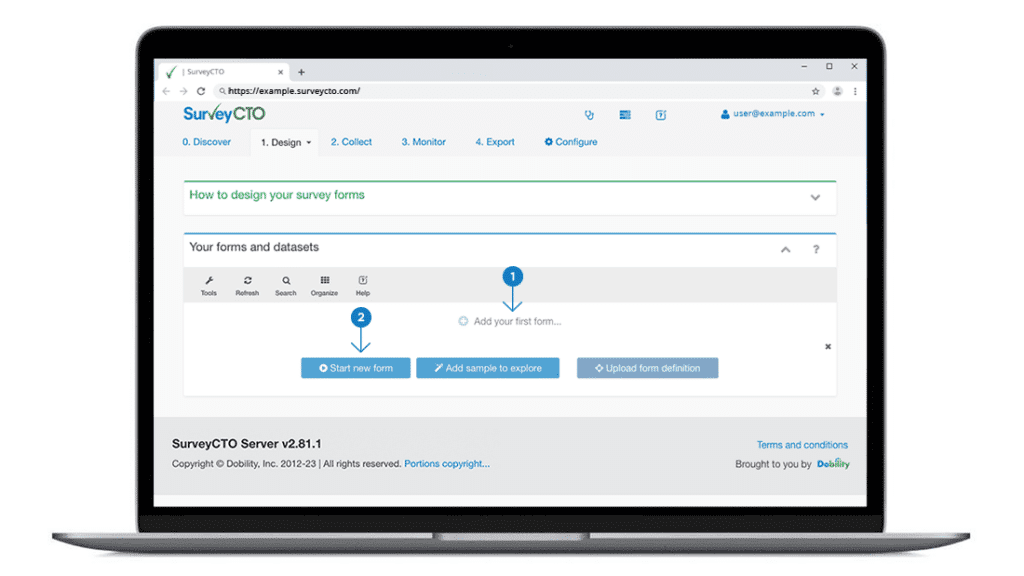Overcome challenges to reliably measure key indicators with the right M&E tools
Whether you’re trying to improve healthcare delivery in rural areas of Sub-Saharan Africa, implement an education and training program to enhance the business skills of participants in a rural community, or do something else, the purpose of your project is to make a tangible difference in the lives of communities and individuals.
Yet, regardless of the scale or amount of funding secured, with any international development project, resources are often scarce, and the challenges are multifaceted. This is where monitoring and evaluation (M&E) can play a pivotal role in ensuring effective resource utilization and that outcomes are optimized and sustainable.
What is monitoring and evaluation and why is it important?

Monitoring in international development programs involves systematically collecting and analyzing data on project activities, outputs, and outcomes to track progress, identify challenges, and inform decision-making throughout the project lifecycle. Evaluation, on the other hand, involves assessing the effectiveness, relevance, efficiency, and sustainability of a development intervention against its intended goals and objectives, typically conducted at specific intervals or at the end of a project. Monitoring and evaluation can also be practiced as part of other frameworks, like Monitoring, Evaluation & Learning (MEL) or Monitoring, Evaluation, Accountability and Learning (MEAL).
Monitoring and evaluating projects is an essential component of effective project management in international development for several reasons:
- Accountability: Monitoring and evaluation provide a means to be accountable to stakeholders, including funders, beneficiaries, and the public, by demonstrating how resources are being utilized and what results are being achieved.
- Continuous learning and improvement: By systematically collecting data and analyzing project performance, organizations can identify what works well and what doesn’t, allowing for adjustments and improvements to be made in real-time.
- Evidence-based decision-making: Monitoring and evaluation provide evidence to inform decision-making regarding project design, implementation strategies, resource allocation, and future programming, ensuring that interventions are based on evidence rather than assumptions.
- Effectiveness and impact: Evaluation helps determine whether project objectives are being met and the extent to which they are contributing to broader development goals, facilitating accountability, and demonstrating the impact of interventions.
- Sustainability: Monitoring and evaluation help organizations understand what factors contribute to project success and sustainability, enabling them to replicate successful approaches in future projects and ensure long-term impact.
Despite the importance of monitoring and evaluating international development projects, implementing a robust M&E program is not without its challenges.
Challenges organizations face in monitoring and evaluation

Numerous challenges can hinder the implementation and effectiveness of M&E processes. Here are some key challenges international development projects often face:
- Data quality: Collecting faulty data due to a lack of proper monitoring processes and tools undermines the accuracy and reliability of M&E efforts. Ensuring data quality and integrity is essential for meaningful M&E outcomes.
- Inadequate or faulty research design: Flawed research designs can compromise M&E outcomes by failing to ask the right questions or establish a strong framework for evaluation.
- Data security: Maintaining confidentiality and security of beneficiary data, especially in crisis-affected areas or sensitive sectors like healthcare, presents ethical and safety challenges.
- Limited time and resource constraints: Limited staff time and insufficient financial resources often hinder effective M&E activities, leading to M&E being deprioritized or compromised monitoring and evaluation processes.
- Technical expertise: A lack of technical expertise within organizations poses challenges in developing and implementing effective M&E processes, particularly in accessing evaluation specialists and building necessary skills.
- Culture and attitudes: Creating a culture that supports learning and growth is essential for effective M&E. Without the right mindset, M&E efforts may be perceived as critical or punitive rather than constructive.
- Lack of focus: With a wealth of data and information available, prioritizing areas for M&E can be challenging. Without a clear understanding of objectives, M&E efforts may become unfocused, yielding limited insights.
- Involving stakeholders effectively: Designing monitoring systems that meet the needs of all stakeholders while providing meaningful information can be challenging. Effective communication and flexibility are crucial for stakeholder engagement and successful M&E implementation
How the right M&E tools can help

When it comes to implementing successful monitoring and evaluation practices, the right tools can make all the difference in overcoming challenges and maximizing efficiency. These tools allow organizations to streamline data collection, strengthen analytical capabilities, and foster a culture of evidence-based decision-making. Ultimately, accurate M&E data gathered with reliable tools can advance the effectiveness and sustainability of development efforts.
Here’s how the right tools can help:
1. Streamlined data collection
Using a mobile data collection platform designed specifically for M&E can make it much faster and easier to collect data in the field than using paper data collection methods. Look for a tool that includes offline data collection capabilities so your data collectors can efficiently gather data in any location, even without internet connectivity.
Challenges solved: By utilizing mobile devices and offline data collection capabilities, organizations can overcome challenges such as time and resource constraints to digitize paper-based data collected in the field. This streamlined approach to data collection helps ensure timely and accurate data collection, mitigating the risk of errors and enhancing the overall efficiency of M&E efforts.
SurveyCTO makes all of this even easier and more streamlined by enabling data collected in one form to be pre-loaded into other forms in the same workflow wherever data collection takes place. In addition, cases can be transferred offline between enumerators’ devices. This empowers teams to re-assign work in reaction to changing conditions on the ground and to work together more efficiently even when offline.
2. Real-time data monitoring and quality assurance
Data quality is paramount in M&E, as it directly influences the reliability and credibility of evaluation outcomes. Technology-driven solutions offer real-time data monitoring and can also include automated checks, validation mechanisms, and quality assurance features that enable researchers to identify and rectify data inconsistencies promptly.
Challenges solved: Real-time data monitoring and automated quality checks enable researchers to identify and address data quality issues promptly. For instance, with SurveyCTO, teams can set up automated quality checks and real-time data monitoring on as many fields as they want. In addition, if any of the quality checks are triggered (i.e., if some aspect of the form’s data “fails” to meet your set quality data standards), then SurveyCTO will issue data-quality warnings in a report. This ensures the integrity and reliability of collected data, mitigating the risk of inaccuracies and addressing challenges related to data quality and security. Additionally, by implementing rigorous quality assurance processes, organizations can enhance the integrity of their evaluation results and build trust with stakeholders.
3. Longitudinal data management
Monitoring indicators over time is essential for assessing the long-term impact of development interventions. However, managing longitudinal data can be complex and time-consuming without the right tools. By incorporating historical data into current assessments, organizations can address challenges related to data monitoring and ensure continuity in M&E efforts. Advanced data management platforms provide capabilities for organizing and analyzing longitudinal data sets efficiently.
Challenges solved: Select a tool designed to manage longitudinal and entity-based data collection seamlessly. With solutions like SurveyCTO’s case management feature, researchers can record key data points over time and incorporate data from previous surveys into current forms, facilitating ongoing monitoring and evaluation efforts. This holistic approach to data management enables organizations to track progress and measure impact accurately over time, facilitating evidence-based decision-making and programmatic improvements.
4. Offline data collection in low/no-connectivity environments
Many development projects operate in remote or low-connectivity environments where internet access is limited or unreliable. Offline data collection tools address this challenge by allowing researchers to collect data without internet connectivity.
Challenges solved: Having a mobile data collection tool that enables organizations to overcome challenges related to data security and accessibility in remote settings is crucial to many international development programs. With a tool like SurveyCTO, that enables offline surveys and workflows, researchers can collect data in the field without worrying about connectivity issues. This ensures data collection continuity and minimizes disruptions to M&E activities. If you use complex data flows that rely on multiple forms collecting data that needs to be available in the same interview or visit, then you’ll also want an M&E tool, like SurveyCTO, that can offer you the advanced offline features you need to run any workflow offline.
5. Capacity building and support services
Adopting new technology requires capacity building and technical support to maximize its benefits. Many technology providers offer training programs and support services to help organizations navigate the implementation and utilization of M&E tools effectively.
Challenges solved: By investing in capacity-building initiatives, organizations can empower staff with the skills and knowledge needed to leverage technology for improved M&E outcomes. SurveyCTO not only offers 24/7 global support services that address technical questions, but our support staff has expertise in research best practices and can provide advice and strategies that can help organizations more effectively and efficiently implement, manage, and evaluate their projects. We also provide a free online course to all new users, and offer the option of in-person paid training for enterprise accounts.
There are solutions to your M&E challenges

The ability to collect, analyze, and act upon data is paramount for organizations striving to make a positive impact on communities worldwide. Monitoring and evaluation serve as a cornerstone for assessing program effectiveness, tracking progress, and ensuring accountability. To meet the numerous M&E challenges though, it’s important to have the right tools.
SurveyCTO is a robust mobile data collection platform designed to streamline M&E efforts. It includes features like offline data collection, real-time data monitoring and automated quality checks, and easy-to-use templates to help you get started. In addition, SurveyCTO enables the management of longitudinal data collection, syncs offline data to its cloud-based servers when internet connectivity becomes available, and provides 24/7 global support services that address technical questions and optimize form and workflow design. Using SurveyCTO, organizations can easily optimize their monitoring and evaluation processes and glean deeper insights into program impact that can ultimately improve outcomes for beneficiaries.
Try SurveyCTO for free and experience firsthand how it can not only support but also improve your monitoring and evaluation practices.




